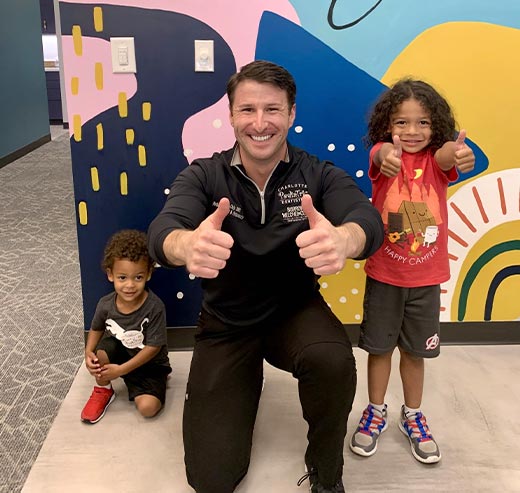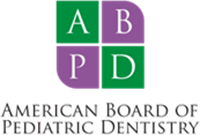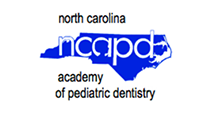It’s easy to tell your children to floss their teeth every day, and you can try to do it for them - but it would be a lot easier if you could demonstrate to them how flossing works and why it’s important. Charlotte Pediatric Dentistry walks you through this simple demonstration from the Nova Scotia Dental Association, step-by-step to help you explain how to floss, to your kids.
Why Flossing is So Important for Kids
As a parent, you know how important brushing is when caring for your children’s teeth (starting after the first tooth is in). What may not be on your radar, but is just as important, is flossing. By around age 2, you should be flossing your child’s teeth daily.
One of the most common dental issues we see in our patients, aged 5-11, is gum disease. Regular flossing is one way to help combat the onset of gum disease. While this all might make sense, the next question that enters parents’ minds is “How do I get my kid to floss?” We have a few suggestions that may be of help.
- Track their progress. Kids love to see how they are doing with a visual guide (even better if there is some type of reward associated with achievement). For each day they floss, you can mark the calendar with a sticker.
- Sing it out. Try singing a fun song with your child. "Floss, floss, floss your teeth. Every single day. Gently, gently, gently, gently, Whisking plaque away."
- Equip them with fun flossing gear. There are several types of colorful flossing sticks that may appeal to your child. While these won’t get the entire job done, they give kids some ownership (and color!) in the process. Letting them work on a few of the front teeth to see what it looks like will likely make it easier for you to finish out the job. Be sure to double-check their work, as well as floss the hard-to-reach teeth in the back. For the best results, make sure you are using real floss, not the sticks.
- Show and tell. One of the ways kids learn is by watching their parents. Show them, in your own daily routine, that flossing is important by setting aside time each day to do so. Bonus: your own oral health will improve as well!
- Use legos and playdough. For the younger kids, showing them the importance of flossing on dolls or toys can be a great teaching tool. One mom took it a step further and used legos and playdough!
Although it’s vital to start teaching your children the importance of flossing at a young age, they likely won’t be able to do the task solo until they are around 10 years old.
When you come into our office, we will talk with your kids about each step of what we’re doing to care for their teeth (and, of course, flossing is one of those steps!). Reinforcing those concepts at home will help ensure your child has good oral health throughout adolescence and into adulthood.
When to Start Flossing Baby Teeth
As your child grows and starts to get more and more teeth, it’s time to start thinking about flossing. Parents often wonder when is the appropriate time to start flossing their children’s teeth and Charlotte Pediatric Dentistry has the answer for you, as well as tips on how to floss their tiny teeth.
You should break out the dental floss for your baby once they have teeth that touch. Touching adjacent teeth can start to collect bacteria and plaque.
If you start flossing your baby’s teeth as soon as they have two that are touching, you can help prevent them from developing gum disease, cavities, and other future dental issues. Flossing cleans the surfaces of teeth that a toothbrush cannot clean thoroughly.
Tips for Flossing Baby Teeth
We know the thought of getting your toddler to sit still long enough to floss their teeth sounds impossible, but it’s really important that you take the time to keep their mouth healthy.
When you first start flossing your baby’s teeth, Charlotte Pediatric Dentistry recommends an adult help with flossing, rather than the child doing it themselves. This will help prevent any trauma to the gums, as well as help your child learn how to floss.
It’s best to start simple and slow. Select an area of your child’s teeth that is easy to see and access. Only floss a few teeth to begin with, and then steadily add another tooth each night. This helps both you and your child build a patience for the flossing routine.
What You’ll Need for the Peanut Butter Flossing Demonstration
Before you get started, you’ll need to gather your materials. You will need:
- Rubber glove
- Peanut butter (or something other sticky food, i.e. jelly, marshmallow fluff, or Nutella)
- Dental floss
- Toothbrush
- Toothpaste
Teaching Your Kids to Floss at Home
Put the rubber glove on one hand and smear the peanut butter between your four fingers. Then, squeeze your fingers together and hold your hand up to show your children. Your fingers represent the teeth, while the peanut butter represents food and bacteria that get stuck in the teeth and cause cavities.
While still squeezing your fingers together tightly, use the toothbrush and toothpaste to clean away the peanut butter. After you’ve brushed them, open up your fingers to reveal how much peanut butter is still left between them. This reiterates how much bacteria and food particles are still left in the mouth and on the teeth even after thoroughly brushing.
Now, squeeze your fingers tightly back together again and let your child use the dental floss to go between each finger and remove the peanut butter. This is a great time to teach proper flossing techniques. Instruct them to move the floss in a zig-zag motion, making a C-shape around the fingers.
Put Flossing into Practice
After the demonstration, your child should have a better understanding of how flossing works and why it is crucial for their dental health. Now it’s time to have your children start flossing on a daily basis. Supervise them to ensure they are flossing each tooth from the front to the back.
Contact Charlotte Pediatric Dentistry for More Dental Hygiene Tips
If you’re having trouble with getting your child to brush or floss, or having trouble explaining why dental health is so important, contact Charlotte Pediatric Dentistry. Oral health education and community service are two of our core values. Our team of doctors is dedicated to ensuring your child grows up with a healthy smile.








